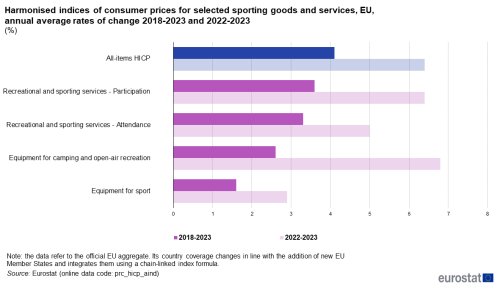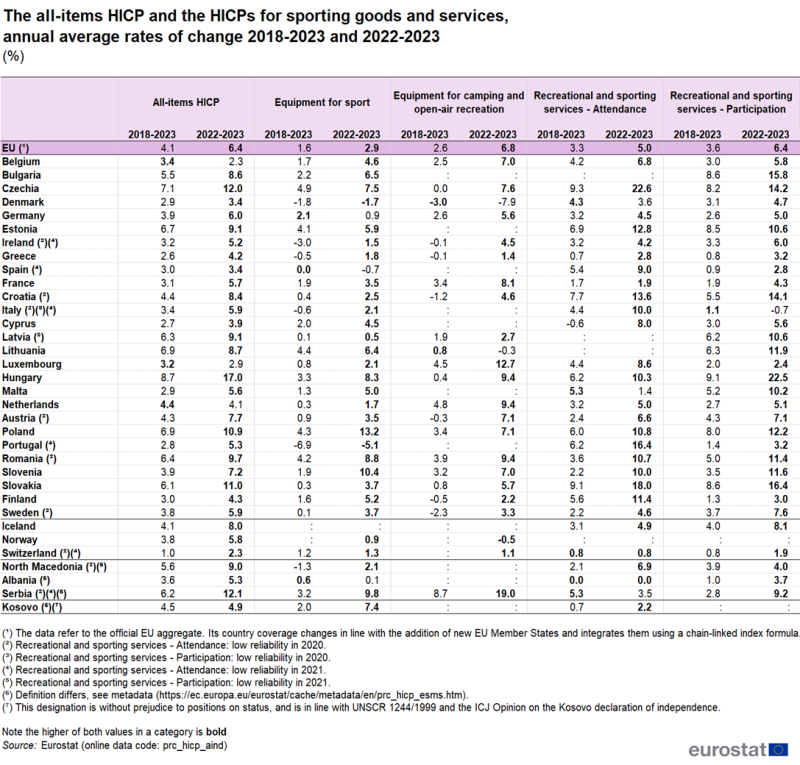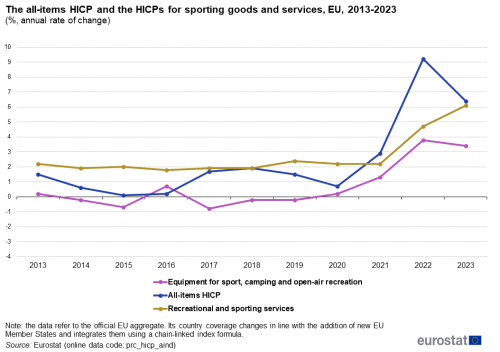HICP for sporting goods and services – trends at EU level
In the HICP two categories are directly related to sport: equipment for sport, camping and open-air recreation and recreational and sporting services, which are further divided into sub-categories equipment for sport and equipment for camping and open-air recreation for equipment and recreational and sporting services – Attendance and recreational and sporting services – Participation for services.
Over an 11-year period, between 2013 and 2023, the annual average rate of change for prices of ’recreational and sporting services’ in the European Union (EU) was 2.7 %, which was 0.3 percentage points faster than for the all-items HICP (2.4 %). This annual average rate of change was significantly influenced by the accelerating inflation in 2022 and 2023. The annual rate of change of the ’recreational and sporting services’ index was 4.7 % in 2022 compared to 2021 and 6.1 % in 2023 compared to 2022. Before 2022, the annual average rate of change stayed around 2 % (see Figure 1).
The annual average rate of change for prices for ’equipment for sport, camping and open-air recreation’ was 3.8 % in 2022 and 3.4 % in 2023. Similarly to the sports service prices, this index increased at a much slower pace before 2022. On average, it increased annually by 0.7 % between 2013 and 2023.
Source: Eurostat (prc_hicp_aind)
The annual average rate of change shows that prices for ’recreational and sporting services – participation’ and ’recreational and sporting services – attendance’ rose on average from 2018 to 2023 by 3.6 % and 3.3 %, respectively, in the EU as a whole. The average annual average rates of change for the same period were lower for ’equipment for camping and open-air recreation’ and ’equipment for sport’, 2.6 % and 1.6 %, respectively (see Figure 2).
Prices increased faster between 2022 and 2023 than they did between 2018 and 2023 for all sporting goods and services sub-categories. This acceleration in the rate of change for 2023 compared to 2022 was particularly evident for ’equipment for camping and open-air recreation’ (6.8 % compared to 2.6 % in 2018-2023) and ’equipment for sport’ (2.9 % compared to 1.6 % in 2018-2023).

(%)
Source: Eurostat (prc_hicp_aind)
HICP for sporting goods and services – focus on countries
Table 1 provides data on consumer prices for sporting goods and services in EU Member States, three European Free Trade Association (EFTA) countries, four candidate countries and one potential candidate. All EU Member States recorded an increase in the all-items HICP in 2023 compared to 2018. In 15 EU Member States, the 2018-2023 HICP annual average rate of change was below the EU average of 4.1 %, with the smallest increase seen in Greece (2.6 %). During the same period, prices of ’equipment for sport’ fell in five EU Member States, notably in Portugal (-6.9 % per year). An increase in the annual rate of change for ’equipment for camping and open-air recreation’ sub-index was observed in 12 EU Member States (data were not available for seven countries).
From 2018 to 2023, prices for both recreational and sporting services increased in all EU Member States where data were available, except in Cyprus where prices of ’recreational and sporting services – attendance’ declined (-0.6 %). The biggest increases were recorded in Czechia (9.3 %) for ’recreational and sporting services – attendance’ and in Hungary (9.1 %) for ’recreational and sporting services – participation’.

(%)
Source: Eurostat (prc_hicp_aind)
Source data for tables and graphs
Data sources and methodology
Eurostat publishes harmonised indices of consumer prices (HICPs), which provides a comparable measure of inflation for EU Member States and various products and services. These indices measure changes over time for prices of consumer goods and services bought by households.
The HICP uses the European classification of individual consumption according to purpose adapted to the needs of the HICP (ECOICOP-HICP). The following items belong to ECOICOP ’Equipment for sport, camping and open-air recreation’:
- Equipment for sport:
- gymnastic, physical education and sport equipment such as balls, shuttlecocks, nets, rackets, bats, skis, golf clubs, foils, sabres, poles, weights, discuses, javelins, dumb-bells, chest expanders and other body-building equipment;
- parachutes and other sky-diving equipment;
- firearms and ammunition for hunting, sport and personal protection;
- fishing rods and other equipment for fishing;
- equipment for beach and open-air games, such as bowls, croquet, frisbee, volleyball, and inflatable boats, rafts and swimming pools;
- game-specific footwear (ski boots, football boots, golfing shoes and other such footwear fitted with ice-skates, rollers, spikes, studs, etc.);
- protective headgear for sports;
- other protective gear for sports such as life jackets, boxing gloves, body padding, shin-guards, goggles, belts, supports, etc.
- Equipment for camping and open-air recreation:
- tents, sleeping bags, backpacks includes air mattresses and inflating pumps, camping stoves, barbecues and other accessories related to camping.
The following items belong to ECOICOP-HICP ’Recreational and sporting services’:
- Recreational and sporting services — Attendance:
- services provided by sports stadiums, horse-racing courses, motor-racing circuits, velodromes, etc. for the attendance of a sportive or recreational event;
- services provided by fairgrounds and amusement parks.
- Recreational and sporting services — Participation:
- skating rinks, swimming pools, golf courses, gymnasia, fitness centres, tennis courts, squash courts and bowling alleys;
- roundabouts, see-saws and other playground facilities for children;
- pin-ball machines and other games for adults other than games of chance;
- ski slopes, ski lifts and the like;
- hire of equipment and accessories for sport and recreation, such as aeroplanes, boats, horses, skiing and camping equipment;
- out-of-school individual or group lessons in bridge, chess, aerobics, dancing, music, skating, skiing, swimming or other pastimes;
- services of mountain guides, tour guides, etc.;
- navigational aid services for boating;
- hire of game-specific footwear (ski boots, football boots, golfing shoes and other such footwear fitted with ice-skates, rollers, spikes, studs, etc.).
Context
The multiannual work programme (EU Work plan for Sport for 2021-2024), agreed by the EU Council, sets the priorities and principles for cooperation between the European Commission and the EU Member States in the field of sport.
Several expert groups have been set up to achieve concrete results. Among them, the Expert Group on the Economic Dimension of Sport (XG ECO) and the Expert Group on Health-Enhancing Physical Activity (XG HEPA) play a key role in implementing evidence-based policies in the sports sector. XG ECO, for example, has developed an economic definition of sport (‘Vilnius definition‘), and made progress towards developing Sport Satellite Accounts in some EU countries. XG HEPA is working on implementing the Council recommendations on physical activity adopted in 2013. These include a monitoring framework with indicators for both the level of physical activity and policies to promote physical activity in EU countries.
Eurostat comparable data on international trade, employment in sport, participation in sporting activities, etc. make a valuable contribution to monitoring and developing the EU’s policies in this area.

